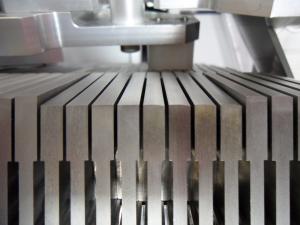A deliberate error to predict ITER behaviour
12 Nov 2012
-
Phil Dooley, EFDA
A deliberately misaligned tile stack is being prepared for installation in JET.The experiment is part of the exploration of material behaviour that JET is carrying out on ITER's behalf. © EFDA-JET
JET's role as a test bed for ITER operation is crucial to the success of the giant tokamak being built in the south of France—so crucial that JET is now preparing to make a deliberate error, just to predict how ITER will behave in such a situation.
The situation in question is the melting of a tungsten tile: the picture at right shows the deliberately misaligned tile stack being prepared for installation in JET. It will be located in JET's exhaust system, the divertor, an area at the bottom of the vessel in contact with the plasma. During operation the plasma circulates around the vessel at high speed guided by the magnetic field lines, which meet the walls in the divertor at a very low angle.
The heat load is spread by the particles skimming the surface in this way, but any part sticking out—putting its head above the parapet—will be subject to up to thirty times more heat than its properly aligned neighbours.
The experiment is part of the exploration of material behaviour that JET is carrying out on ITER's behalf. Tungsten has an important role in tokamaks as the metal with the highest melting point, 3,422 degrees celsius—obviously a great advantage when containing hot plasma. However if tungsten does get vaporized and contaminate the plasma, its large number of electrons give rise to a lot of radiation, which can seriously affect energy confinement.
Since fusion plasmas usually operate in the range of hundreds of millions of degrees, reaching 3,422 degrees and melting tungsten does not sound hard—in fact it has been done before in experiments in other devices. What complicates this experiment is the requirement to melt the tile with transient heat generated by turbulent events known as Edge Localized Modes, or ELMs. While the base temperature of the tiles can be easily modelled and controlled to prevent melting, the sudden bursts of energy supplied by ELMs may be less predictable in ITER's larger, hotter plasma.
JET, as the largest operational tokamak in the world, is the only facility that has enough energy in its plasma to achieve a transient melt. Its ELMs are much studied—they can occur up to 30 times a second, but last less than a millisecond, so it will take care to get the peak temperatures above the melting point while keeping the steady temperature below. It is hard to know exactly how much damage these events could cause.
"After a melt, the best result would be if the next few pulses remove or erode the melted material and then we are back to operation that is as good as before," says Chief Engineer Valeria Riccardo. Just to be on the safe side the area chosen for the melt, Tile 5, Stack A, is at one end of the assembly. "It's an area not used much as the plasma contact point because it is difficult to achieve good density control in that configuration. That way even if the damage is not recoverable we can still use the better configurations for other experiments."


